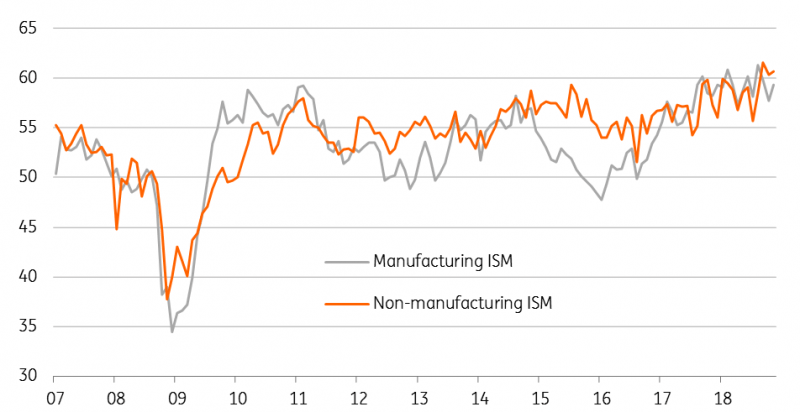A fourth 25bp hike for 2018, but with growth headwinds intensifying and market tensions rising the Federal Reserve will tread a more cautious path in 2019.
A more dovish hike
The Fed has hiked its policy rate 25bp to 2.25-2.5% as widely expected, but there is a dovish narrative to the accompanying press release and forecast pace. Having signalled back in September that 3 rate hikes in 2019 was the most likely scenario, 5 FOMC members lowered their projection so the median forecast is now for just two 25bp moves in 2019. They still expect one more rate hike in 2020, but have lowered the longer run projection for the Fed funds rate to a median of 2.8% from 3%. Their predictions for growth, unemployment and inflation were little changed.
The statement incorporates these forecast changes by inserting the word “some” to the assessment that “some further gradual increases” in interest rates will be needed. It also inserts a comment stating the Fed will “continue to monitor global economic and financial developments and assess their implications for the economic outlook” – perhaps hinting they are keeping a watchful eye on equities. There are some other very subtle changes here and there, but all clearly gave the impression the Fed is looking to slow the pace of rate hikes from the four seen in 2018.
Headwinds are intensifying
2018 has been a great year for the economy with output likely expanding at the fastest rate for 13 years and unemployment hitting a 49-year low, but 2019 will undoubtedly see more economic headwinds. The lagged effects of higher borrowing costs – a 30Y fixed rate mortgage is averaging 5% - and a strong dollar will act as a brake while the support from this year’s fiscal stimulus will fade. At the same time concerns about trade tensions, weaker external demand and the resulting hefty declines in the stock market add to the sense of tougher times ahead. This will mean that the Federal Reserve takes a more cautious, data dependent approach to policy decisions next year
US ISM business surveys remains strong despite trade fears

Source: Macrobond
But there is still reason for optimism
However, there are the upsides from the strong labour market, which is finally feeding into higher worker pay. At the same time, business surveys, such as the ISM reports, remain at very strong levels and given the lack of spare capacity in the US economy we see core inflation continuing to rise through the first half of 2019. In addition, the recent plunge in energy costs could help support consumer demand and if the US and China can resolve their differences this could provide a major boost to the global economic outlook. As such, the fact financial markets are not even fully pricing in one rate hike in 2019 seems far too complacent at this stage.
The skew toward two
We have been forecasting three rate hikes in 2019 for some time, but there is a lot of economic and market uncertainty, particularly relating to trade. We also have to remember that the Federal Reserve is shrinking its balance sheet while there is growing talk – most notably from Lael Brainard – concerning raising the countercyclical buffers. This could be used as a way of shoring up financial risks while also tightening monetary conditions. Consequently we, like the Federal Reserve, see the risks increasingly being skewed towards just two hikes in 2019.
Read the original article: The Fed hikes, but a slowdown is coming
Content disclaimer: This publication has been prepared by ING solely for information purposes irrespective of a particular user's means, financial situation or investment objectives. The information does not constitute investment recommendation, and nor is it investment, legal or tax advice or an offer or solicitation to purchase or sell any financial instrument. Read more here: https://think.ing.com/content-disclaimer/
Recommended Content
Editors’ Picks
EUR/USD edges lower toward 1.0700 post-US PCE

EUR/USD stays under modest bearish pressure but manages to hold above 1.0700 in the American session on Friday. The US Dollar (USD) gathers strength against its rivals after the stronger-than-forecast PCE inflation data, not allowing the pair to gain traction.
GBP/USD retreats to 1.2500 on renewed USD strength

GBP/USD lost its traction and turned negative on the day near 1.2500. Following the stronger-than-expected PCE inflation readings from the US, the USD stays resilient and makes it difficult for the pair to gather recovery momentum.
Gold keeps its daily gains near $2,350 following US inflation

Gold prices maintain their constructive bias around $2,350 after US inflation data gauged by the PCE surpassed consensus in March and US yields trade with slight losses following recent peaks.
Bitcoin Weekly Forecast: BTC’s next breakout could propel it to $80,000 Premium

Bitcoin’s recent price consolidation could be nearing its end as technical indicators and on-chain metrics suggest a potential upward breakout. However, this move would not be straightforward and could punish impatient investors.
Week ahead – Hawkish risk as Fed and NFP on tap, Eurozone data eyed too

Fed meets on Wednesday as US inflation stays elevated. Will Friday’s jobs report bring relief or more angst for the markets? Eurozone flash GDP and CPI numbers in focus for the Euro.